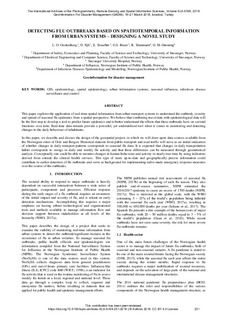| dc.contributor.author | Grottenberg, Lars Ole | |
| dc.contributor.author | Njå, Ove | |
| dc.contributor.author | Tøssebro, Erlend | |
| dc.contributor.author | Braut, Geir Sverre | |
| dc.contributor.author | Tønnessen, Ragnhild | |
| dc.contributor.author | Grøneng, Gry Marysol | |
| dc.coverage.spatial | Norway | nb_NO |
| dc.date.accessioned | 2019-02-26T12:30:37Z | |
| dc.date.available | 2019-02-26T12:30:37Z | |
| dc.date.created | 2018-07-03T10:55:32Z | |
| dc.date.issued | 2018-03 | |
| dc.identifier.citation | Grottenberg, L.O., Njå, O., Tøssebro, E. et al. (2018) Detecting flu outbreaks based on spatiotemporal information from urban systems - designing a novel study. International Archives of Photogrammetry, Remote Sensing and Spatial Information Sciences. 42 (3/W4), pp. 231-237. | nb_NO |
| dc.identifier.issn | 1682-1750 | |
| dc.identifier.uri | http://hdl.handle.net/11250/2587474 | |
| dc.description.abstract | This paper explores the application of real-time spatial information from urban transport systems to understand the outbreak, severity and spread of seasonal flu epidemics from a spatial perspective. We believe that combining travel data with epidemiological data will be the first step to develop a tool to predict future epidemics and to better understand the effects that these outbreaks have on societal functions over time. Real-time data-streams provide a powerful, yet underutilised tool when it comes to monitoring and detecting changes to the daily behaviour of inhabitants.
In this paper, we describe and discuss the design of the geospatial project, in which we will draw upon data sources available from the Norwegian cities of Oslo and Bergen. Historical datasets from public transport and road traffic will serve as an initial indication of whether changes in daily transport patterns corresponds to seasonal flu data. It is expected that changes in daily transportation habits corresponds to swings in daily and weekly flu activity and that these differences can be measured through geostatistical analysis. Conceptually one could be able to monitor changes in human behaviour and activity in nearly true time by using indicators derived from outside the clinical health services. This type of more up-to-date and geographically precise information could contribute to earlier detection of flu outbreaks and serve as background for implementing tailor-made emergency response measures over the course of the outbreaks. | nb_NO |
| dc.language.iso | eng | nb_NO |
| dc.publisher | Copernicus Publications | nb_NO |
| dc.relation.uri | https://www.int-arch-photogramm-remote-sens-spatial-inf-sci.net/XLII-3-W4/231/2018/isprs-archives-XLII-3-W4-231-2018.pdf | |
| dc.rights | Navngivelse 4.0 Internasjonal | * |
| dc.rights.uri | http://creativecommons.org/licenses/by/4.0/deed.no | * |
| dc.subject | epidemiologi | nb_NO |
| dc.subject | folkehelse | nb_NO |
| dc.subject | influensa | nb_NO |
| dc.subject | urbane informasjonssystemer | nb_NO |
| dc.subject | epidemiology | nb_NO |
| dc.subject | infectious disease surveillance and control | nb_NO |
| dc.subject | urban transport | nb_NO |
| dc.title | Detecting flu outbreaks based on spatiotemporal information from urban systems - designing a novel study | nb_NO |
| dc.type | Journal article | nb_NO |
| dc.type | Peer reviewed | nb_NO |
| dc.description.version | publishedVersion | nb_NO |
| dc.rights.holder | © Authors 2018. | nb_NO |
| dc.subject.nsi | VDP::Samfunnsvitenskap: 200::Urbanisme og fysisk planlegging: 230 | nb_NO |
| dc.subject.nsi | VDP::Medisinske Fag: 700::Helsefag: 800::Epidemiologi medisinsk og odontologisk statistikk: 803 | nb_NO |
| dc.source.pagenumber | 231-237 | nb_NO |
| dc.source.volume | 42 | nb_NO |
| dc.source.journal | International Archives of Photogrammetry, Remote Sensing and Spatial Information Sciences | nb_NO |
| dc.source.issue | 3/W4 | nb_NO |
| dc.identifier.doi | 10.5194/isprs-archives-XLII-3-W4-231-2018 | |
| dc.identifier.doi | 10.5194/isprs-archives-XLII-3-W4-231-2018 | |
| dc.identifier.cristin | 1595377 | |
| cristin.unitcode | 217,8,3,0 | |
| cristin.unitcode | 217,8,4,0 | |
| cristin.unitname | Institutt for sikkerhet, økonomi og planlegging | |
| cristin.unitname | Institutt for data- og elektroteknologi | |
| cristin.ispublished | true | |
| cristin.fulltext | original | |
| cristin.qualitycode | 1 | |

